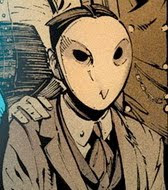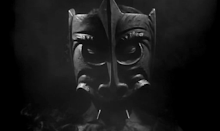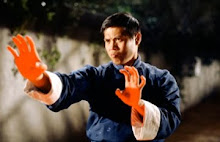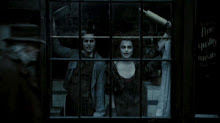But I feel like sharing them anyway, both because I think that there's some genuine insight here, and also because I'm curious the response my writing that's a bit less conversational will get. Writing in other words where I am not dropping the F Bomb every other word, and the grammar is actually correct.
Crazy I know.
But lets give it a shot.

I’m afraid I can’t quite accept Kurosawa as a post modernist. The core theme running through his films is that of responsibility, to ourselves and others. Something I find lacking in post modernist thought. To quote Paul Schrader in his illustration of the difference between Post Modern film and Modern film (Or as he phrases it between Existential film and Ironic film.) “The existential dilemma is, 'should I live?' And the ironic answer is, 'does it matter?' Everything in the ironic world has quotation marks around it You don't actually kill somebody; you 'kill' them. It doesn't really matter if you put the baby in front of the runaway car because it's only a 'baby' and it's only a 'car'." (
In Kurosawa it is never just a “baby” or just a “car”. Things matter in Kurosawa film, it is more then simple play. That said, I concede that looking at Kurosawa, through a postmodernist lens, particularly that of Baudrillard’s, can add some very interesting shading’s to Kurosawa’s work. Following this logic, let us begin with Kagemusha, the film of Kurosawa’s I find most open to the Post Modernist eye.
It is tempting to look at Kagemusha as pastiche, after all it had been fifteen years since he had made a jidai-jeki with Red Beard, and at least seventeen years since he had made a Samurai film with Sanjuro. This partnered along with it’s making, could give rise to the idea that the American’s where simply buying themselves a “real” Samurai film, a Simulacrum Samurai if you will. However, I cannot read Kagemusha as such. It is too mournful, too contemplative, too impressionistic, and too mindful of the violence it creates to equate with Kurosawa’s earlier films. If anything it is a piece of Intertextual cinema examining itself. In other words rather then the pastiche of the Post Modernist, I feel that Kurosawa has created the Revisionist film of the Modernist. (It is interesting to note that Richie appears to disagree, but almost subconsciously he notes, “that it proved to be such a richly engrossing experience, such a Kurosawa-like entertainment,”
Still the central drama of Kagemusha does fit nicely with Baudrillard’s concept of the Simulacrum. The men in the field, and the warlord’s enemies do not know that their enemy is truly dead, because his signifier remains. As Baudrillard puts it in The Precession Of The Real “The Disneyland imagery is neither true nor false, it is a deterrence machine set up in order to rejuvenate the fiction of the real in the opposite camp.” The fact that the signifier is a false one doesn’t matter, it has the same affect as a true one as Baudrillard says in Precession of the Simulacrum “We require a visible past, a visible continuum, a visible myth of origin, which reassures us about our end.” , even though the signified is no longer present, it simply makes no difference.
However, Kagemusha goes even farther, as Baudrillard and his predecessor Saussure argue it is only through a “web of meaning” that the signifier is defined. The Thief cannot merely proclaim himself to be the king, and have any affect it is only when the lords and generals decide to play along that the deception is successful. And it is only when one crucial strand of the web decides not to play along that the carefully crafted “reality” of the signifier falls apart. By the end of the film, both the signifier and the signified have been destroyed; reality has ended because of the general consensus to end it.
At the end of Kagemusha “The Thief” is gone. He has played so much time playing the signifier of another thing, that he cannot go back to being the signifier for himself. He has forgotten how, which brings to mind Baudrillard’s statement in The Perfect Crime, “The image can no longer imagine the real since it is the real. It can no longer dream reality since it is virtual reality. From screen to screen, the image has no other destiny but the image.” The Thief has no other recourse, but to fulfill the “destiny” that does not truly belong to him. Even though he is no longer seen by other’s as the emperor, and indeed never has been, he has come to believe his own Simulcra, and thus must end fulfill it to its last fatalistic step. Or as Bauldrillard puts it in Precession Of The Simulacrum, “Illusion is no longer possible, because the real is no longer possible.”
High and Low, seems to fit deceptively well in into the Post Modern interpretation. Kurosawa makes a very schematic film, one half art film focusing on one man the rest a sprawling “policier” which covers great swatches of Tokyo, along with a title that practically dares you to make a clever observation. However, structural issues aside High and Low has always been Kurosawa’s most Marxist film. With it’s villain rising up as an avenger of the underclass, and it’s hero subtly indicted as part of the problem as a “good” and ignorant bourgeois.
In short it is in a way the flipside of Kagemusha, which I see as a Modernist examination of Post Modern issues, High And Low is in turn a post modern view on a modernist issues, for which we must call in Jameson.
It is perhaps odd just how many of High and Low’s Concepts correspond to Jameson, in a textual way, when Jameson speaks of Lynch’s Mapless city, “space in which people are unable to map (in their minds) either their own positions or the urban totality in which they find themselves” (Jameson 89) It is easy to remember that Kurosawa’s character’s spend about 1/3 of the film traversing urban sprawl begging a child to give them their bearings. Or the central image of the house itself or as Jameson might say “the "semiautonomy of the cultural realm: “ts ghostly, yet Utopian, existence, for good or ill, above the practical world of the existent, whose mirror image it throws back in forms which vary from the legitimations of flattering resemblance to the contestatory indictments of critical satire or Utopian pain.”
Still it is in the end of High And Low that I find what is perhaps the central metaphor to this little argument. Many have argued that High And Low was Kurosawa’s response to the rise of the nouvelle vague like Seizuiki and Fukusaku, proof that he could play their game. If we do except that this is so, then it behooves us to examine what happens in the last scene.
There’s Mifune, the consummate modernist, the one who wishes to make good shoes for people, tied in other words to both the signified and signifiers and then there’s the doctor, who hunts without pity or remorse among the anonymous. The Post Modernist of the pair has taken everything from Mifune, his status, his safety, his wealth, but at the end of the picture there is Mifune stoic and unbowed, and there is the Doctor, his stylistic howlings, echoing in the empty space he has created.




































































































No comments:
Post a Comment